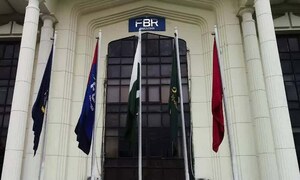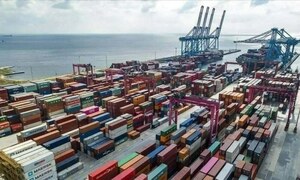The statement by the Governor of the State Bank of Pakistan to the Pakistan Business Council on the 15th of September highlighted the positives in the economy. Clearly, the tone was upbeat so as to motivate the members of the PBC, who are mostly multinational companies that have invested in Pakistan.
The editorial of the Business Recorder titled 'SBP Governor's Observations' of the 20th of September has commented on the very rosy picture presented on the economy and emphasized on the need for caution. The Annual Report of the SBP for 2016-17 is due in the next few weeks, followed by the first Quarterly report for 2017-18. Hopefully, these Reports will present a somewhat more balanced assessment. The, more or less, common perception at this time is that the economy has unraveled and we could be moving into a period of financial difficulties.
The Governor has rightly highlighted the improved performance of exports, remittances and FDI in the first two months. Unfortunately, the recovery has not been strong enough to neutralize the continuing fast growth of imports of as much as 28 percent. Consequently, the trade deficit has increased by 39 percent in July and August 2017 combined and, the current account deficit has more than doubled. Unless the growth of imports is restrained quickly by various strong measures, the balance of payments position will continue to be unsustainable.
There is also need to recognize that the vulnerability has been enhanced by a number of other developments in the balance of payments. Repatriation of profits has gone up by 15 percent in 2016-17. It is unlikely that corporate profits may have increased so much in dollar terms. There has been a 49 percent increase in the trade deficit on services in July and August 2017. A significant withdrawal of portfolio funds has taken place from Pakistan during this period. To top it all, repayment of external debt has gone up by a massive 144 percent.
Clearly, there are no grounds for complacency at this time. Some of the negative developments may, in fact, be linked to some speculation about an impending depreciation in the value of the rupee. This may also partly explain the phenomenal jump in imports and recent build up of foreign currency accounts. As such, there is a need for taking a quick and firm decision on the exchange rate and signaling this to the markets.
The Governor has extolled the excellent growth rate of 5.3 percent achieved by the economy in 2016-17, the highest in the last 10 years. Unfortunately, there is strong evidence that the growth rate is somewhat exaggerated and closer to 4.4 percent. First, with a small increase in the overall investment rate and falling exports the conditions were not conducive for achieving high growth. This was made possible by the Pakistan Bureau of Statistics (PBS) by showing an extraordinary jump in the growth rate of consumption spending of over 9 percent, highest since 1991-92.Surely, this is far from the ground realities.
Second, on the production side, the growth rate in value added in eight out of the 18 sectors of the national economy has been significantly overstated. This includes sectors like livestock, electricity and gas, construction, wholesale and retail trade, etc. The SBP may note that the finance and Insurance sector is shown by PBS as achieving a double-digit real growth rate of almost 11 percent in 2016-17. How could this have happened when commercial bank profits, according to SBP, have fallen in real terms by almost 10 percent during the year? This alone brings the GDP growth rate down to below 5 percent.
The role of expansionary monetary policy in promoting growth has also been highlighted in the statement. This includes the extraordinary growth in incremental credit to the private sector of 67 percent to Rs 748 billion, in the presence of very low interest rates. The Governor states that 40 percent of this, equivalent to almost Rs 300 billion, was meant for fixed investment.
Here again PBS figures are very different. Apparently, the rate of private investment has actually fallen to 9.9 percent of the GDP from 10.2 percent in 2015-16, as presented in the Pakistan Economic Survey (PES). Further, PBS estimates that, at current prices, private fixed investment has increased by only Rs 196 billion, much less than that indicated by SBP. The time has come for SBP and PBS to reconcile their figures. Could it be that investors in 2016-17 have substituted their equity contributions with larger and cheaper debt financing?
The SBP role in enhancing the volume of agricultural credit must be appreciated, especially to small farmers. Fertilizer off-take has increased by 26 percent in the first nine months of 2016-17, according to the PES. It is indeed disappointing that this has only led to a 3 percent increase in the output of crops. Reasons for this lack of response need to be studied.
The policy rate has been maintained at a low rate of 5.75 percent since March 2016. There is need to focus on the impact on the domestic savings rate. At 7.5 percent of the GDP, according to the PBS, this is the lowest rate since 2004-05. Consequently, the investment-savings gap has increased and led to a widening of the trade deficit. It has also kept the cost of inventories low, especially of imported goods.
The other area of concern is the record expansion in government borrowing from the SBP. During the three years of the IMF programme the stock of public debt with the SBP was brought down each year. However, following the completion of the programme, almost Rs 888 billion financing has been made by the SBP in 2016-17. This has, no doubt, implied less 'crowding out' of the private sector and access to credit from commercial banks. However this will generate inflationary pressures on the economy with some lag. This change in the policy of financing the fiscal deficit has to be at least partially changed in 2017-18. First, indications up to September 8 are that this is beginning to happen following the arrival of the new Governor.
The final blow to any optimism is the continuing decline in foreign exchange reserves in the first two and a half months of the current financial year by over $1.8 billion. At this rate, reserves could fall below the level required for providing import cover of at least two months by April 2018. Of course, this decline may be arrested by strong policy actions on the trade and other fronts. However, this has not yet happened.
The Federal Ministry of Finance is in some disarray currently. The Governor of SBP will have to a play a leadership role in managing the external balance of payments of the country. We wish him success in avoiding recourse to the IMF by Pakistan.
(The writer is Professor Emeritus and former Federal Minister)
BR100
11,839
Decreased By
-27.2 (-0.23%)
BR30
35,827
Increased By
129.6 (0.36%)
KSE100
113,563
Decreased By
-585.5 (-0.51%)
KSE30
35,742
Decreased By
-210.4 (-0.59%)

























Comments
Comments are closed.